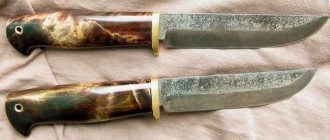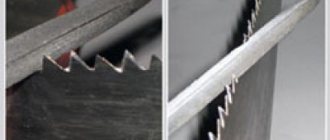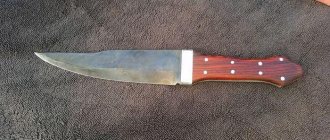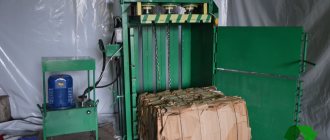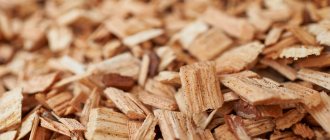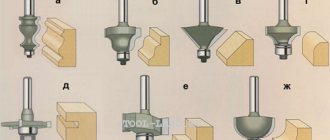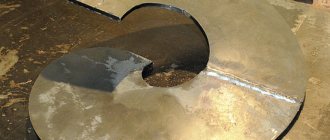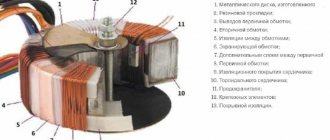If a chainsaw breaks down, runs out of gas, or a hand saw is not suitable for cutting a thick log, then for this there is a tool such as a two-handed saw, more popularly known as Druzhba-2. Previously, such a device was used to cut thick logs and large trees. Today, Druzhba-2, although it has decreased in popularity, continues to be used on the farm. To simplify the use of a two-handed wood saw, we will consider the process of how to make the tool even more convenient and practical, and find out the effectiveness of using the cutting device.
Why is the file called “Friendship-2”
Surely everyone knows this type of chainsaw tool called “Friendship”. The next chainsaw model was to receive an appropriate name with the prefix “two”, but the name “Friendship-2” went to such a cutting device as a two-handed saw. It got its name due to its design features. A two-handed crosscut saw is designed to work in pairs, and not just two people. In a pair - this means well-coordinated friendly work with the device, which is where the name actually originated back in the USSR.
The Soviet two-handed saw was popular because its main advantage was its low cost. During the Soviet era, few people could afford to buy a specialized tool - a chainsaw, which cost astronomical amounts of money. Cutting thick logs and large trees with a hand saw is not only difficult, but it also takes a lot of time. That is why such a type of cutting unit as Druzhba-2 appeared.
Even if there is now a two-handed saw from the USSR era in your garage or attic, do not rush to get rid of it. It can not only cut trees and logs, but also make various tools, for example, a knife or a handsaw. If you remember that a two-handled hacksaw is gathering dust somewhere in the garage, then it’s time to find out all its advantages and capabilities.
Types and areas of application of the tool
The main purpose of a hacksaw is to cut metal products, cut seams, grooves, trim workpieces along outlined contours, etc. In addition, a hacksaw allows you to cut not only metal, but also, for example, foam plastic, ceramic products, plastic, organic glass and even wood.
- Hacksaw for metal - recommendations for choosing and using hand and electric tools
In general, hacksaws for metal are divided into three types:
- home models are the most common and affordable option, which is optimal for performing simple tasks around the house and is particularly comfortable to use. Often, such hacksaws are equipped with additional tension screw mechanisms, combined with a wooden handle located longitudinally to the blade;
- professional hacksaws - suitable for longer work and obtaining precise cuts. Hacksaws of this level are equipped with a comfortable rubberized handle and make it possible to install the blades at an angle to make non-standard cuts;
- hacksaw-handle - has a special shape in the form of a bracket for working in hard-to-reach places. The equipment in such hacksaws is cantilevered and secured on only one side. The design of the hacksaw handles allows you to install even broken saw blades and is perfect for internal cuts.
Design features of the file
This two-person tool is also called a crosscut saw, which belongs to the category of hand-held devices and is used primarily for sawing wood materials of various sizes and thicknesses. For this purpose, the saw has different lengths of blades - from one meter to two. It is inconvenient for one person to hold such a long blade, so the design of the device has two handles. Not only in Soviet times, but even today, the production of two-handed hacksaws continues in compliance with standard sizes:
- 1 meter or 1000 mm
- 1.25 meters or 1250 mm
- 1.5 meters or 1500 mm
- 1.75 meters or 1750 mm
The blade does not have a straight shape, but a rounded one, which is made specifically to increase the efficiency of sawing, as well as reduce the load. The teeth on the blades are large compared to hand saws, and their size is 20 mm. Even if you use a meter-long file, it is inconvenient to work with it yourself. There are several reasons for this:
- The large length does not allow the sawyer to make a strong swing
- Large saw teeth are difficult to bite into wood, and therefore the sawyer alone cannot cope with actuating the cutting device
- Strong vibration increases the load, as well as reduces the efficiency of the actions performed.
Saws with blades of 1000 and 1250 mm are popular due to the fact that they have a simplified design. Hacksaws with blades of 1500 and 1750 mm were used primarily in industry for sawing construction and wood materials. If they are found in the household, they are exclusively saws with blades of 1 m and 1.25 m. They have classic triangular links, the sharpening angle of which varies from 35 to 70 degrees.
- To cut dry and frozen logs, it is recommended to use a cross-cut saw with a tooth sharpening angle of 50-70 degrees.
- For sawing soft wood, a tool with sharpened links at an angle of 35-40 degrees is used.
Two-handed saws with blades from 1.5 meters have a complex design, which simplifies the use of a large unit. Special sharpening and shape of the teeth on large saw blades are needed to perform high-quality and fast cutting of wood material. The principle of sawing with a hacksaw with a long blade (1.5-1.75 m) differs from the operation of saws with 1 m and 1.25 m in that half of the teeth are responsible for cutting through the fibers, and the second part contributes to the rapid and efficient removal of chips from under the cut site.
This is interesting!
If ordinary hacksaws for wood and two-handed saws up to 1.25 meters long can be sharpened independently, then a hacksaw with a blade of more than 1.5 meters, which has a complex tooth shape, can only be sharpened by specialists with extensive experience and experience.
If you come across a saw with a complex tooth shape, do not rush to sharpen it at home. If you do not take into account the difference of fractions of millimeters in the complex design of the teeth, then an attempt to restore integrity will lead to complete damage to the two-handed saw. The consequences will be approximately as follows:
- If the difference in the ratio of angles between the cutting and clearing teeth is reduced to one value, then instead of sawing, the blade will tear the wood and only complicate the physical work of sawyers
- If the difference in the ratio of the teeth is large, then the chips will not be effectively removed from the cut, which will also complicate the work
That is why sharpening a crosscut saw requires an appropriate and competent approach. The principle of sharpening a two-handed saw from 1 m to 1.25 m is similar to the process of sharpening the teeth of hand saws.
Making a circular saw with your own hands
A few words about drawings and sketches with dimensions
No two homemade circulars are alike. In 100% of cases there are differences in dimensions, selected material, dimensions and location of the shaft and motor. Therefore, finished drawings are not provided. In order not to be confused about the dimensions, you can sketch out a simple sketch for yourself indicating the height, length and width of the frame blanks.
The following photo is given as an example.
The errors of this design are that the saw blade is shifted from the center to the corner. It is optimal when the length of the disk is located in the middle of the table or with a slight offset towards the back. This leaves more space in front of the disk for stable placement of the workpiece. The width of the disk should also be located far enough from the edge to accommodate a wide workpiece.
A board as a desktop is not the best option.
The advantage of the design is the ability to use the machine not only as a circular saw, but as a workbench. Well suited for cross-cutting firewood; sawn logs close to the edge will fall on their own without stopping on the table.
Machine in the process of assembly
Nuances and stages of assembly
Before assembling the frame, you already need to have an engine, a shaft with pulleys, and a belt.
Individual frame parts can be connected in different ways.
Wood - with bolts and screws. Possibly at some points at the spine/groin junction. At a quarter, etc.
Metal can also be assembled using bolts, welding, or a combination of welding and threaded connections.
First, the frame is assembled. In this case, the mounting location of the engine and shaft is preliminarily determined.
The most important thing in this case is to ensure the alignment of the shaft and the motor shaft. In this case, the shaft and engine pulleys must be located in the same vertical plane. The engine stroke must be provided for tensioning the belt.
The distance between the shaft and the motor is calculated based on standard belt sizes. (730, 750, 775, 800 mm and so on). For larger machines, other sizes may be suitable (1040, 1045, 1050, 1060 mm and so on). It is better if the engine mounting grooves for tensioning are long to be able to install belts of different lengths.
The final fastening of the engine platform is carried out only after the alignment and correct location of the shaft and motor pulleys relative to each other have been verified. In case of distortions, the belt will quickly be eaten. If there is a strong distortion, it will be impossible to work at all. The belt flies off the pulleys.
Alignment is verified in different ways.
- Roulette . The distance between the centers of the engine shafts and the working shaft is measured. It should be the same on both ends.
- Level . The mounting area for the shaft and motor is set strictly according to the construction (carpenter's) level.
- Check by rule or laser . After preliminary mounting of the shaft and motor, a flat surface (usually a corner) is applied to the pulleys. The surface should lie flat against the pulleys over the entire surface. The presence of a gap indicates that the pulleys are misaligned. Instead, you can usually use a marking laser beam.
The power supply and switch are connected after mounting the motor and installing the shaft. It is more convenient to do this in the absence of a table. A push-button three-position package from old washing machines (activator type) works well. It is installed on the right front leg or hidden next to it, under the table cover. This is important so that the switch is not accidentally broken, for example by a falling workpiece.
The desktop is attached to the frame last
Example - instructions for step-by-step manufacturing of a wood sawing machine
Let's look at one of the popular options for making a circular machine with your own hands on a metal frame using an asynchronous motor from a washing machine. Previously, we have already told you how to make a circular machine with a washing machine motor, and we also provided detailed instructions, but in this case you will get a radically different design, so no repetitions, only new ideas.
To make it you will need:
- metal corner;
- profile pipe;
- driving and driven pulley;
- Belting;
- shaft with bearing;
- metal or plywood sheet.
To make a machine for cutting wood, you need to perform the following steps:
- Measure the distance between the electric motor mounting studs.
- Cut two blanks from a metal corner. In one part, drill holes with a diameter of 6 mm to fix the motor. In the other there is a longitudinal groove for connection to the frame.
- Connect the corners to the electric motor. To increase the reliability of the structure, it is better to use a lock washer and a lock nut.
- As a driven shaft, it is best to use an axis from an angle grinder, onto which 2 ball bearings are pre-pressed. To extend the service life of the mechanism, it is best to use bearings with a closed race.
- It is necessary to weld the frame of the frame from a profile pipe. A nut is welded onto the upper cross member into which the driven shaft will be installed. Holes are drilled in the lower ones to install the engine.
- To reduce vibration during operation and increase the stability of the structure, silicone or plastic bushings are attached to the bottom of the frame, which act as legs.
- Install the shaft and driven pulley into the seat.
- A washer and a nut for fixing the saw blade are installed on the opposite side of the shaft.
- We install the engine and V-belt drive into the mounting holes. By moving the electric motor along the frame, we set the required belt tension. After that, fix it with a nut and a locknut.
- We make the working surface of the machine from sheet metal 2 mm thick or plywood 20 mm, having previously cut out a groove in it for the saw blade to come out and holes for connecting to the bed.
- Secure the table using countersunk screws.
- Connect the plug to the power terminal on the motor.
After completing all of the above manipulations, you can start working on a homemade circular saw.
After watching the video, you can see in more detail how to make a stationary machine for cutting wood with an asynchronous motor from a washing machine.
We also recommend reading interesting articles in which we looked at how to make a circular saw from a drill or grinder.
How to saw with a two-handed saw - detailed instructions with description
At first glance, the process of sawing with a two-handed saw may seem easy and straightforward. However, as soon as a beginner takes up a hacksaw, it immediately becomes clear that this is a job for real and strong hands. However, you don’t have to have a mountain of muscles to properly cut wood with the Druzhba-2 saw. To do this, you need a little experience and also understand the principle of operation.
This is interesting!
Even if you have experience working with short-stroke hacksaws, a beginner who picks up a two-handed saw for the first time will be unpleasantly surprised.
If an experienced sawyer stands at the other end of the saw, then a beginner will have a hard time until he masters the principle of operation of the device. Instructions on how to cut logs and trees with a two-handed saw are as follows:
- First, the log must be secured by placing it on the “goats”. It must be taken into account that it is most convenient to carry out the work while standing on your feet, so even if the log lies on the ground, then in order to cut it correctly, you should place it on a special stand - sawhorses
- The section of the log that is sawn off from the main part should hang above the ground
- Both sawers take a comfortable position with their feet shoulder-width apart. The main thing here is to firmly support your feet, otherwise the possibility of injury cannot be ruled out.
- Ideally, it is recommended that one of the sawers position himself slightly higher than the other, for example, by placing a tray. This will speed up the cutting, but is not at all mandatory.
- By holding the handles of the tool, you can begin. The main thing when working with a two-handed hacksaw is synchronized work with your hands. The effectiveness of achieving the final result depends on smooth hand work.
- The principle of pair sawing is as follows: it is necessary to apply force only in one direction - to pull the blade towards you. There is no need to push the tool away from you, since this task is assigned to your partner. While the partner is pulling the blade towards himself, the hand of the first sawyer is resting
- In this way, not only work efficiency increases, but also rapid fatigue is eliminated
The speed of achieving results is influenced by many factors, such as the thickness of the log, the length of the blade, the quality of sharpening the teeth, as well as the synchronized work of the sawmills. It is worth noting that with the right approach to sawing, it is possible to achieve fast sawing comparable to the operation of a chainsaw.
This is interesting!
If the blade has signs of corrosion deposits, then before carrying out work it is recommended to clean the surface with fine sandpaper (to speed up the work, you can use a hand brush for metal), and then apply machine oil to reduce resistance when working with the tool.
How to cut with a two-handed saw alone
It often turns out that it is difficult to find a partner for sawing, so it becomes necessary to use the tool alone. It is impossible to do this without first modifying the saw, so it remains to figure out how to turn a two-handed hacksaw into a one-handed one, while maintaining the length of the blade. There is a way out, and it is quite simple - turn a flexible hacksaw into a rigid bow saw. All you need to do is make a frame.
- The first way to make a frame is to attach a beam or a narrow board to the existing handles on top with self-tapping screws. At this point, the manufacture of a long saw for hand sawing can be considered complete. The disadvantage of homemade products is that the blade will vibrate, so if you want to get a more reliable tool, you should choose the second option
- The two-handed saw uses two wooden handles that are removable. In the cylindrical holes on the canvas, it is necessary to install two elongated sticks, between which a rail of the required length should be placed crosswise. In the upper part, parallel to the rail, pull a rope, which ensures tension of the web. As a result, you can work the device alone without a partner, adjusting the degree of tension
If you plan to use the hacksaw for work yourself, then the frame can be welded from metal pipes. This design will be more reliable and will last no less than the tool blade. The principle of the conversion is simple and uncomplicated, so if you have accumulated a bunch of thick logs, then it’s time to cut them with a two-handed hacksaw alone.
This is interesting!
You can buy a crosscut saw, since modern manufacturers continue to produce this type of device, allowing themselves to modernize it. Instead of primitive handles in the form of cylindrical bars, full-fledged handles are used, as on ordinary hand hacksaws.
Sharpening two-handed saws yourself or how to simply restore an old long hacksaw
If you have an old two-handed hacksaw Druzhba-2 in the garage, then before using it, it is recommended to restore its integrity. Before using the tool, pay attention to the following points:
- Handles - wooden handles may have dried out over a long period of non-use, so it is possible that they could freely fall out of the holes. You can restore the serviceability of the handles by dipping them in water for several hours so that they swell. You can also machine new handles for the tool, which won’t take a lot of time and effort.
- The presence of corrosion on the canvas - signs of rust should be eliminated, and then treat the device with machine oil
- Sharpening the teeth - after storing the tool for a long time in the garage, there is a high probability that the hacksaw needs to restore the sharpness of the teeth
If there are no difficulties with restoring the handles and removing corrosion, then sharpening the teeth is just the opposite. A large saw requires a lot of time and effort to restore the integrity of the links. However, there is an advantage to this, since large teeth are much more convenient to sharpen. Although the tool differs from an ordinary hand hacksaw, however, the principle of restoring the sharpness of the teeth is similar. A step-by-step description of sharpening teeth on a two-handed saw has the following format:
- First you need to fix the tool. It will not be possible to do this in the jaws of even the largest vice, so we use two corresponding board lengths. We place the boards parallel to the blade, leaving only the teeth visible. If you don’t have a vice, you can use a clamp
- Work should begin with setting the teeth. All teeth must be the same height. You can determine the presence of protruding links by eye, and to align them with the rest, you should work with a flat file
- At the next stage, it is necessary to align the teeth at the same angle of deviation from the plane of the blade. To perform the wiring, you will need a special tool. It is also recommended that you first make a template (layout) to check whether the links are sufficiently spaced (or buy one). The teeth should be spaced 0.5 mm from the plane of the blade or 1 mm from each other. The wiring process is performed one by one. Not many craftsmen know how often to set teeth. According to the rules, it is necessary to carry out setting no more often than 1 time per 5-6 sharpening of teeth
- As soon as the teeth are set apart, you can move on to the final and most important stage - sharpening. For this, a special triangular file is used, the size of which must be no less than the height of the teeth
- Correct sharpening is performed by moving the file away from you with medium pressure against the tooth. In the reverse position, the file should not touch the blade. It is necessary to pass the file confidently, but not quickly
- First you need to go along one side of the teeth, and then along the other. When sharpening, you should also choose the appropriate angle from 35 to 70 degrees.
Finally, all that remains is to treat the tool blade with machine oil and use it for sawing thick logs, trees and even lumber. When carrying out work, it is recommended to follow safety precautions to avoid injury.
This is interesting!
If you have mastery of working with a grinder, you can sharpen the teeth with a power tool with an abrasive disc.
Designs of homemade machines
There are three main elements at the heart of any circular, two of which cannot be made by yourself:
- engine.
- shaft, with jointing knives or the simplest, without them.
Third, the bed (table) is easy to make on your own.
You can make such a stand with your own hands without any problems.
Additional elements are also required:
- starter, switch for the electric motor;
- electrical wire;
- drive belt;
- pulleys on the shaft and motor.
For circular machines with an internal combustion engine (ICE), instead of a wire and a switch, a fuel tank is needed.
Main types of structures:
- The disk is mounted directly on the engine, without a belt or gear drive.
- The disk is mounted on a shaft with a belt drive.
- The shaft is the simplest, only for the disk.
- Shaft with jointing knives.
The first option is the simplest, but with a big drawback. The height of the engine “eats up” most of the working diameter of the disk. If the engine has a diameter of, for example, 200 mm, then a disk with a diameter of 200 mm will protrude above it by only 100 mm. Another part of this distance is reduced due to the motor mounts, connection box, and the thickness of the desktop.
As a result, only the outermost part of the disk diameter, where the greatest “lever” of resistance to engine rotation will actually work, will work. Even with a large blade, the cutting depth remains small, since the blade protrudes little.
If you install the motor with the blade on the side of the table, with the motor elevated relative to the table, the width of the cut will be limited. The wide piece will rest against the engine housing. It is impossible to extend the motor shaft with attachments, since the disk must be located as close as possible to the bearing. In another case, decentration of the shaft, beating and wobbling of the disk are possible.
The second option, the simplest shaft, also inevitably “eats” the working height of the disk, but much less. Only to the height of the bearing carriage from the center of the shaft. Therefore, when choosing a finished shaft, the height of the carriage matters. For powerful shafts this is 80-120 mm (40-60 mm from the center of the shaft). For thin shafts with small bearings 60-80 mm (30-40 mm).
The option with a shaft and belt allows you to select the number of revolutions of the saw blade due to the size of the pulleys on the motor and shaft. The belt can also act as mechanical engine protection. If it is not tightened, when the disk gets stuck in the workpiece, the belt slips along the pulleys, but the engine does not jam.
The option with jointing knives significantly expands the capabilities of the machine. The design can be more complex, with the front of the table being raised to adjust the planing depth.
The simplest option is also possible, without an adjustment platform. In this case, the planing depth is set by the position of the knives in the shaft itself. This option is suitable for rough processing. For example, on jointing knives with a planing depth of 3-5 mm, you can plan one surface lightly. Then, having one flat plane to move along the table, cut the workpiece on the remaining sides with a saw blade.
Interesting ideas on what can be made from a two-handed saw
If a two-handed saw is not used for its intended purpose or a certain number of teeth are missing on the blade, then there is no need to rush to get rid of it. If it cannot be used as a large saw, then many different, interesting and useful devices can be made from it. First, let's find out why a two-handed saw is used to make various devices? The reasons for this popularity are as follows:
- The instrument of the USSR era was made using high-quality high-strength steel grade 9ХФ, with a thickness of 1 to 3 mm. Nowadays it is almost impossible to find such steel
- Strict compliance with GOST 980-80 and manufacturing standards, which improves the quality of the canvas
- Corrosion resistance
Now that we know why it is worth choosing a two-handed saw of the “Friendship-2” type for making various devices, let’s figure out what can be made from it.
- Hand saw.
The first thing you can make from the two-handed hacksaw Druzhba-2 is a hand hacksaw. The principle of making an ordinary hacksaw is simple - you need to draw the shape of the future tool on the canvas with chalk or pencil. Then, using a grinder, cut it according to the template, and attach the handle to the resulting workpiece. The handle can be bought or removed from a Chinese file - Knife from a two-handed saw Friendship 2
(or throwing knives) - similarly, the blank of the future knife is cut out using a template, and then the blade is sharpened and the handle is prepared. When sharpening, you must take into account that this must be done with a file, but not emery. After all, excessive heating of the metal will lead to a decrease in strength properties - Spring
- the type of device in question has enormous shock-absorbing properties, which allows the device to be used for the manufacture, for example, of a catapult or other similar devices
There are many options for using unnecessary crosscut saws on the farm. What to make from it all depends on what is needed on the farm - a good knife, a hand saw or other tools.
To summarize, it should be noted that a two-handed saw is worth giving it a second life. After all, Druzhba-2, even from those times, is a real rarity that can last at least a couple of decades. Today you can also buy modern two-handed hacksaws from manufacturers such as Zubr, Matrix, Sibrtech and others. If you compare their quality with domestically produced files, they cope with the tasks no worse. The cost of a new cross-cut saw ranges from 400-600 rubles, which depends on the manufacturer.
